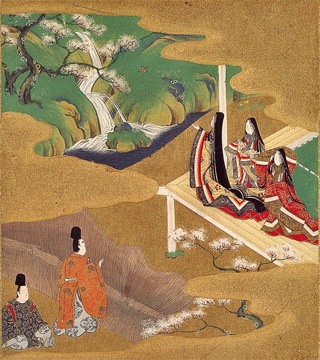Kōdō
 ‘Listen to the fragrance.’ This expression, which at first may appear slightly awkward in terms of the five senses we use in daily life, refers to the classical refined art of incense burning, or kōdō (literally, the way of fragrance), which originated in Japan.
‘Listen to the fragrance.’ This expression, which at first may appear slightly awkward in terms of the five senses we use in daily life, refers to the classical refined art of incense burning, or kōdō (literally, the way of fragrance), which originated in Japan.
It has been known since olden times that fragrances have the power to heal and relax, as they have been incorporated in daily life in many ways throughout history. In recent years, aromatherapy, which uses essential oils extracted from plants, has become popular.
Kōdō, however, involves a different set of sensibilities, and is more correctly positioned as an art form in Japan based on its specific appreciation of the fragrances of rare aromatic woods (kōboku) native to Southeast Asia.
Legend has it that in the year 595 during the reign of Empress Suiko, a log of incense wood (agarwood) drifted onto the shores of Japan. Kōdō culture itself became popularized as part of Buddhist ceremony, and in the Heian Period (794–1185) the custom of burning incense was further developed amongst the court nobility as an aristocratic affair. After the Kamakura Period (1185–1333), kōdō was supplemented with the principles of bushido (the samurai way of life) and Zen doctrine.
In the Muromachi Period (1336–1573), kōdō attained further sophistication with use of a system called Rikkoku-gomi (six countries, five scents), in which fragrances are classified according to six factors: country of origin, and the five scents of sourness, bitterness, sweetness, pungency, and saltiness.
Words were born and utensils and manners were created in order to enrichen the world of kōdō, whichdeveloped within Japanese culture as a way to enhance spirituality and sociality.
Kōdō’s popularity expanded in the Edo Period (1603–1868) when it was also taken up by the citizenry, but at the same time the historical formalities and manners associated with appreciating incense were lost from daily life, due to trends in modernization.
However, in recent years kōdō in its original form has witnessed somewhat of a revival, and opportunities to casually experience it, such as in temples, have risen. The most popular way to appreciate incense is by playing genjikō, a type of game involving different fragrances.
While one might assume ‘listening to the fragrance’ is not that a difficult task, it actually involves becoming acutely aware of the nuances in a single fragrance that are affected by, for example, changes in temperature and humidity. Similarly, as everyone has their own particular sensitivities, it is a great joy to experience the exquisite manners of kōdō as demonstrated by the host or hostess in enjoying the aroma of incenses, as well as to witness differences in individual sensitivities.
The aromatic woods used for kōdō are made using natural processes. Trees such as daphne (Aquilaria agallocha) produced in certain parts of Southeast Asia secrete an aromatic resin which they use for self-healing, which over time turns them into kōboku. These trees are therefore very rare and highly prized.
Along with the dissemination of kōdō culture and the recent rise in demand, however, has been an increase in cases of illegal logging and harvesting of trees in protected areas, as well as destruction of such areas to exploit natural resources, which are growing problems.
What needs to be borne in mind is the spirit of kōdō culture, which arose from a deep respect for nature possessed by our ancestors, and it is this ethos that needs to be passed down to future generations.
Figure: Several episodes about kō (incense) are described in The Tale of Genji, a classic work of Japanese literature written in the Heian Period. (Image from The Tale of Genji by Tosa Mitsuoki, 1617–91.)
(Makiko Imai)










